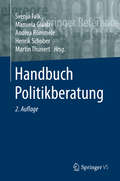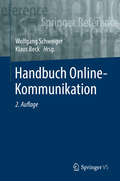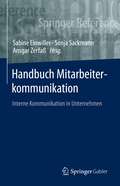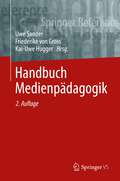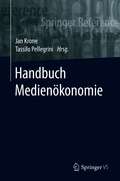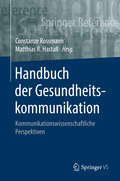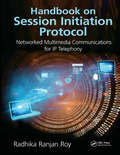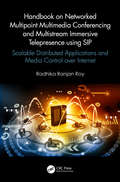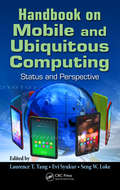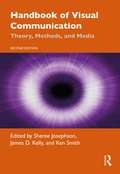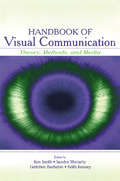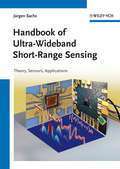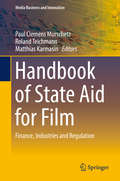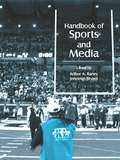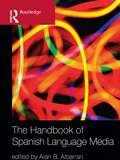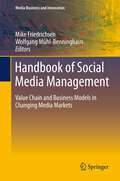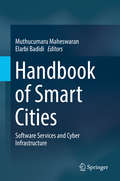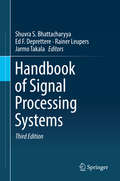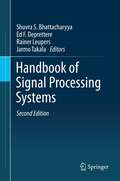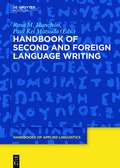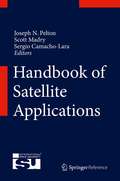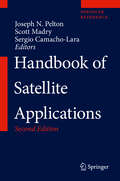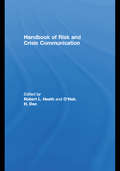- Table View
- List View
Handbuch Politikberatung
by Svenja Falk Manuela Glaab Andrea Römmele Henrik Schober Martin ThunertPolitik braucht Beratung und der Bedarf wächst. In diesem Handbuch werden daher relevante Felder der Politikberatung systematisch dargestellt, neue Entwicklungen analysiert und aktuelle Trends aufgezeigt. Neben den Grundlagen, Strukturen und Akteuren sowie den Feldern von Politikberatung finden erstmals deren Methoden und Instrumente differenziert Berücksichtigung.
Handbuch Online-Kommunikation
by Wolfgang Schweiger Klaus BeckDas Handbuch gibt in 23 Beiträgen einschlägiger FachautorInnen einen umfassenden und systematischen Überblick des aktuellen Forschungsstandes kommunikationswissenschaftlicher Online-Forschung. Einführend werden die zentralen Fragestellungen, theoretischen Ansätze und empirischen Befunde dargestellt. Das Themenspektrum reicht von den Grundlagen computervermittelter Kommunikation (interpersonale, Gruppen- und öffentliche Kommunikation), über ökonomische, ethische und politische Fragen wie Regulierung und Kontrolle des Internets, sowie seine Verbreitung, Nutzung und Wirkung. Weitere Beiträge befassen sich mit Öffentlichkeit und Journalismus online, kulturellen und sozialpsychologischen Aspekten, Online-Werbung und -PR, Gesundheitskommunikation, E-Learning und Wissensmanagement sowie Online-Spielen. Ein Überblick über Methoden der Online-Forschung sowie die wichtigsten Datenquellen und Standarduntersuchungen rundet das Werk ab.
Handbuch Mitarbeiterkommunikation: Interne Kommunikation in Unternehmen
by Sabine Einwiller Sonja Sackmann Ansgar ZerfaßDas Handbuch vermittelt einen ganzheitlichen Überblick zu Mitarbeitenden als Zielgruppe und Akteure der Kommunikation von Unternehmen und anderen Organisationen. Diskutiert werden verschiedene Ebenen der internen Kommunikation: Interne Unternehmenskommunikation zwischen Unternehmensleitung und Mitarbeitenden sowie Führungskräften, Teamkommunikation, Führungskommunikation und informelle Mitarbeiterkommunikation. Daneben werden relevante Schnittstellen und Themen der externen Kommunikation adressiert wie Employer Branding und Arbeitgeberkommunikation. Kennzeichnend ist die interdisziplinäre Verknüpfung der Perspektiven von Kommunikationswissenschaft, Betriebswirtschaftslehre und Psychologie sowie die konsequente Orientierung an Herausforderungen der Unternehmensführung in der digitalen und globalisierten Gesellschaft. Das Handbuch richtet sich an Interessierte aus der Wissenschaft, Praxis sowie an Studierende aus den genannten Bereichen und angrenzenden Fachgebieten.
Handbuch Medienpädagogik
by Uwe Sander Friederike Von Gross Kai-Uwe HuggerDas Handbuch Medienpädagogik liefert Studierenden, pädagogischen Praktikern und Wissenschaftlern einen fundierten und systematisch aufgebauten Überblick über Theorie, Forschung, Geschichte, gegenwärtige Diskussionspunkte und Handlungsfelder der noch verhältnismäßig jungen erziehungswissenschaftlichen Teildisziplin Medienpädagogik. Unterschiedliche Expertinnen und Experten behandeln Strömungen und Theorien der Medienpädagogik, Methoden und Richtungen der Medienforschung sowie den Zusammenhang von Medienentwicklung und Medienpädagogik. Weiterhin werden Aufgaben und Handlungsfelder sowie berufliche und professionelle Aspekte der Medienpädagogik diskutiert.
Handbuch Medienökonomie
by Jan Krone Tassilo PellegriniDas Handbuch hat den Anspruch, die Medienökonomie vor dem Hintergrund der voranschreitenden Digitalisierung von Kommunikation, Medienproduktion, Medienvertrieb sowie der Anpassung ordnungspolitischer Rahmenbedingungen aus unterschiedlichen disziplinären Zugängen in seiner Gesamtheit abzubilden.
Handbuch Medien und Geschlecht: Perspektiven und Befunde der feministischen Kommunikations- und Medienforschung
by Johanna Dorer Brigitte Geiger Brigitte Hipfl Viktorija RatkovićDer Band bietet einen systematischen Überblick über die Grundlagen, Theorien und empirischen Befunde der feministischen Kommunikations- und Medienwissenschaft. Die Beiträge behandeln die Entwicklungen und den aktuellen Stand der gesamten Breite der kommunikationswissenschaftlichen Geschlechterforschung: Informations- und Unterhaltungsangebote der Medien, Fernseh- und Filmgenres, Social Media, Journalismus, Werbung, Öffentlichkeitsarbeit, Medienpolitik, Medienpädagogik, Medienpsychologie und Medienethik aus Geschlechterperspektive werden ebenso systematisch dargestellt wie die Themen der Frauenbewegung, Gewalt, Körper- und Sexualitätsdiskurse in Medien.
Handbuch Investor Relations und Finanzkommunikation
by Christian Pieter Hoffmann Dirk Schiereck Ansgar ZerfaßDas deutschsprachige Standardwerk zur Kapitalmarktkommunikation bietet einen Überblick zum aktuellen Stand der internationalen Forschung und zur Praxis in diesem jungen und dynamischen Themenfeld. Zugleich dient es als Lektüre für Verantwortungsträger in Vorstand, Geschäftsführung und anderen Funktionen, in Fachbereichen für Investor Relations, Unternehmenskommunikation und Marketing sowie für am Berufsfeld interessierte Studierende. Die Beiträge erläutern zunächst Grundlagen wie regulatorische Erfordernisse, Ansätze der Unternehmensbewertung oder Herausforderungen des Börsengangs. Einen Schwerpunkt bilden die strategische Planung, Organisation, Umsetzung, Instrumente und Evaluation von Investor Relations und Finanzkommunikation. Aufgaben wie die Entwicklung einer Equity Story werden ebenso erklärt wie das Aktienmarketing oder die Unternehmensberichterstattung. Abschließend werden besonders bedeutsame Handlungsfelder wie die Krisenkommunikation, die Kommunikation des Finanzvorstandes oder der Umgang mit aktivistischen Aktionären diskutiert. Das Handbuch verbindet kommunikationswissenschaftliche mit betriebswirtschaftlichen Perspektiven und Erkenntnissen aus den Disziplinen Finance und Accounting.
Handbuch der Gesundheitskommunikation: Kommunikationswissenschaftliche Perspektiven (Springer Reference Sozialwissenschaften Ser.)
by Constanze Rossmann Matthias R. HastallDas Handbuch gibt einen Überblick zum aktuellen Forschungsstand der Gesundheitskommunikation. Im Fokus stehen kommunikationswissenschaftliche Zugänge und Erkenntnisse sowie die Vorteile und Herausforderungen einer stärkeren Evidenzbasierung von Kommunikationsempfehlungen. Die Sektionen des Handbuchs reflektieren einerseits die zentralen Elemente des Kommunikationsprozesses und andererseits die wichtigsten Anwendungskontexte. Das Handbuch richtet sich an Studierende, Wissenschaftlerinnen und Wissenschaftler unterschiedlicher Disziplinen genauso wie an Expertinnen und Experten aus der Praxis.
Handbook on Session Initiation Protocol: Networked Multimedia Communications for IP Telephony
by Radhika Ranjan RoySession Initiation Protocol (SIP), standardized by the Internet Engineering Task Force (IETF), has emulated the simplicity of the protocol architecture of hypertext transfer protocol (HTTP) and is being popularized for VoIP over the Internet because of the ease with which it can be meshed with web services. However, it is difficult to know exactly how many requests for comments (RFCs) have been published over the last two decades in regards to SIP or how those RFCs are interrelated. Handbook on Session Initiation Protocol: Networked Multimedia Communications for IP Telephony solves that problem. It is the first book to put together all SIP-related RFCs, with their mandatory and optional texts, in a chronological and systematic way so that it can be used as a single super-SIP RFC with an almost one-to-one integrity from beginning to end, allowing you to see the big picture of SIP for the basic SIP functionalities. It is a book that network designers, software developers, product manufacturers, implementers, interoperability testers, professionals, professors, and researchers will find to be very useful. The text of each RFC from the IETF has been reviewed by all members of a given working group made up of world-renowned experts, and a rough consensus made on which parts of the drafts need to be mandatory and optional, including whether an RFC needs to be Standards Track, Informational, or Experimental. Texts, ABNF syntaxes, figures, tables, and references are included in their original form. All RFCs, along with their authors, are provided as references. The book is organized into twenty chapters based on the major functionalities, features, and capabilities of SIP.
Handbook on Networked Multipoint Multimedia Conferencing and Multistream Immersive Telepresence using SIP: Scalable Distributed Applications and Media Control over Internet
by Radhika Ranjan RoyHandbook on Networked Multipoint Multimedia Conferencing and Multistream Immsersive Telepresence using SIP: Scalable Distributed Applications and Media Control over Internet is the first book to put together all IETF request for comments (RFCs), and the internet drafts standards related to the multipoint conferencing and immersive telepresence. This book includes mandatory and optional texts of all standards in a chronological and systematic way almost with one-to-one integrity from the beginning to end, allowing the reader to understand all aspects of the highly complex real-time applications. It is a book that network designers, software developers, product manufacturers, implementers, interoperability testers, professionals, professors, and researchers will find to be immensely useful. Practitioners and engineers in all spectrums who are concentrating on building the real-time, scalable, interoperable multipoint applications, can use this book to make informed choices based on technical standards in the market place, on all proprietary non-scalable and non-interposable products. This book will provide focus and foundation for these decision makers.
Handbook on Mobile and Ubiquitous Computing: Status and Perspective
by Laurence T. Yang Evi Syukur Seng W. LokeConsolidating recent research in the area, the Handbook on Mobile and Ubiquitous Computing: Status and Perspective illustrates the design, implementation, and deployment of mobile and ubiquitous systems, particularly in mobile and ubiquitous environments, modeling, database components, and wireless infrastructures.Supplying an overarching perspecti
Handbook of Visual Communication: Theory, Methods, and Media (Routledge Communication Series)
by Sheree Josephson James D. Kelly Ken SmithThis Handbook of Visual Communication explores the key theoretical areas and research methods of visual communication. With chapters contributed by many of the best-known and respected scholars in visual communication, this volume brings together significant and influential work in the discipline. The second edition of this already-classic text has been completely revised to reflect the metamorphosis of communication in the last fifteen years and the ubiquity of visual communication in our modern mediated lifestyle. Thirteen major theories of communication are defined by the top experts in their fields: perception, cognition, aesthetics, visual rhetoric, semiotics, cultural studies, ethnography, narrative, media aesthetics, digital media, intertextuality, ethics, and visual literacy. Each of these theory chapters is followed by an exemplar study or two in the area, demonstrating the various methods used in visual communication research as well as the research approaches applicable for specific media types. The Handbook serves as an invaluable reference for visual communication theory as well as a useful resource book of research methods in the discipline. It defines the current state of theory and research in visual communication and serves as a foundation for future scholarship and study. The Handbook of Visual Communication is a theoretical and methodological handbook for visual communication researchers and a compilation for much of the theoretical background necessary to understand visual communication. It is required reading for scholars, researchers, and advanced students in visual communication, and it will be influential in other disciplines such as advertising, persuasion, and media studies. The volume will also be essential to media practitioners seeking to understand the visual aspects of how audiences use media to contribute to more effective use of each specific medium.
Handbook of Visual Communication: Theory, Methods, and Media (Lea’s Communication Series)
by Kenneth L. Smith Sandra Moriarty Keith Kenney Gretchen BarbatsisThis Handbook of Visual Communication explores the key theoretical areas in visual communication, and presents the research methods utilized in exploring how people see and how visual communication occurs. With chapters contributed by many of the best-known and respected scholars in visual communication, this volume brings together significant and influential work in the visual communication discipline.The theory chapters included here define the twelve major theories in visual communication scholarship: aesthetics, perception, representation, visual rhetoric, cognition, semiotics, reception theory, narrative, media aesthetics, ethics, visual literacy, and cultural studies. Each of these theory chapters is followed by exemplar studies in the area, demonstrating the various methods used in visual communication research as well as the research approaches applicable for specific media types.The Handbook serves as an invaluable reference for visual communication theory as well as a useful resource book of research methods in the discipline. It defines the current state of theory and research in visual communication, and serves as a foundation for future scholarship and study. As such, it is required reading for scholars, researchers, and advanced students in visual communication, and it will be influential in other disciplines in which the visual component is key, including advertising, persuasion, and media studies. The volume will also be useful to practitioners seeking to understand the visual aspects of their media and the visual processes used by their audiences.
Handbook of Ultra-Wideband Short-Range Sensing
by Jürgen SachsRanging from the theoretical basis of UWB sensors via implementation issues to applications, this much-needed book bridges the gap between designers and appliers working in civil engineering, biotechnology, medical engineering, robotic, mechanical engineering, safety and homeland security.From the contents:* History* Signal and systems in time and frequency domain* Propagation of electromagnetic waves (in frequency and time domain)* UWB-Principles* UWB-antennas and applicators* Data processing* Applications
Handbook of State Aid for Film: Finance, Industries And Regulation (Media Business and Innovation Ser.)
by Paul Clemens Murschetz Roland Teichmann Matthias KarmasinThis book is an analysis of the specificities of public film funding on an international scale. It shows how public funding schemes add value to film-making and other audio-visual productions and provides a comprehensive analysis of today’s global challenges in the film industry such as industry change, digital transformation, and shifting audience tastes. Based on insights from fields such as cultural economics, media economics, media management and media governance studies, the authors illustrate how public spending shapes the financial fitness of national and international film industries. This highly informative book will help both scholars and practitioners in the film industry to understand the complexity of issues and the requirements necessary to preserve the social benefits of film as an important cultural good.
Handbook of Sports and Media (Routledge Communication Series)
by Jennings Bryant Arthur A. RaneyThis distinctive Handbook covers the breadth of sports and media scholarship, one of the up-and-coming topics bridging media entertainment, sports management, and popular culture. Organized into historical, institutional, spectator, and critical studies perspectives, this volume brings together the work of many researchers into one quintessential volume, defining the full scope of the subject area. Editors Arthur Raney and Jennings Bryant have recruited contributors from around the world to identify and synthesize the research representing numerous facets of the sports-media relationship. As a unique collection on a very timely topic, the volume offers chapters examining the development of sports media; production, coverage, and economics of sports media; sports media audiences; sports promotion; and race and gender issues in sports and media. Unique in its orientation and breadth, the Handbook of Sports and Media is destined to play a major role in the future development of this fast-growing area of study. It is a must-have work for scholars, researchers, and graduate students working in media entertainment, media psychology, mass media/mass communication, sports marketing and management, popular communication, popular culture, and cultural studies.
The Handbook of Spanish Language Media
by Alan AlbarranWith the rise of Spanish language media around the world, The Handbook of Spanish Language Media provides an overview of the field and its emerging issues. This Handbook will serve as the definitive source for scholars interested in this emerging field of study; not only to provide background knowledge of the various issues and topics relevant to Spanish language media, but also to establish directions for future research in this rapidly growing area. This volume draws on the expertise of authors and collaborators across the globe. The book is an essential reference work for graduate students, scholars, and media practitioners interested in Spanish language media, and is certain to influence the course of future research in this growing and increasingly influential area.
Handbook of Social Media Management: Value Chain and Business Models in Changing Media Markets
by Mike Friedrichsen Wolfgang Mühl-BenninghausDigitization and Web 2.0 have brought about continuous change from traditional media management to new strategic, operative and normative management options. Social media management is on the agenda of every media company, and requires a new set of specialized expertise on digital products and communication. At the same time, social media has become a vibrant field of research for media economists and media management researchers. In this handbook, international experts present a comprehensive account of the latest developments in social media research and management, consistently linking classical media management with social media. The articles discuss new theoretical approaches as well as empirical findings and applications, yielding an interesting overview of interdisciplinary and international approaches. The book's main sections address forms and content of social media; impact and users; management with social media; and a new value chain with social media. The book will serve as a valuable reference work for researchers, students and professionals working in media and public relations.
Handbook of Smart Cities: Software Services and Cyber Infrastructure
by Muthucumaru Maheswaran Elarbi BadidiThis handbook provides a glimpse of the research that is underway in smart cities, with an examination of the relevant issues. It describes software infrastructures for smart cities, the role of 5G and Internet of things in future smart cities scenarios, the use of clouds and sensor-based devices for monitoring and managing smart city facilities, a variety of issues in the emerging field of urban informatics, and various smart city applications. Handbook of Smart Cities includes fifteen chapters from renowned worldwide researchers working on various aspects of smart city scale cyber-physical systems. It is intended for researchers, developers of smart city technologies and advanced-level students in the fields of communication systems, computer science, and data science. This handbook is also designed for anyone wishing to find out more about the on-going research thrusts and deployment experiences in smart cities. It is meant to provide a snapshot of the state-of-the-art at the time of its writing in several software services and cyber infrastructures as pertinent to smart cities. This handbook presents application case studies in video surveillance, smart parking, and smart building management in the smart city context. Unique experiences in designing and implementing the applications or the issues involved in developing smart city level applications are described in these chapters. Integration of machine learning into several smart city application scenarios is also examined in some chapters of this handbook.
Handbook of Signal Processing Systems
by Shuvra S. Bhattacharyya Ed F. Deprettere Rainer Leupers Jarmo TakalaIn this new edition of the Handbook of Signal Processing Systems, many of the chapters from the previous editions have been updated, and several new chapters have been added. The new contributions include chapters on signal processing methods for light field displays, throughput analysis of dataflow graphs, modeling for reconfigurable signal processing systems, fast Fourier transform architectures, deep neural networks, programmable architectures for histogram of oriented gradients processing, high dynamic range video coding, system-on-chip architectures for data analytics, analysis of finite word-length effects in fixed-point systems, and models of architecture. There are more than 700 tables and illustrations; in this edition over 300 are in color. This new edition of the handbook is organized in three parts. Part I motivates representative applications that drive and apply state-of-the art methods for design and implementation of signal processing systems; Part II discusses architectures for implementing these applications; and Part III focuses on compilers, as well as models of computation and their associated design tools and methodologies.
Handbook of Signal Processing Systems
by Ed F. Deprettere Jarmo Takala Rainer Leupers Shuvra S. BhattacharyyaHandbook of Signal Processing Systems is organized in three parts. The first part motivates representative applications that drive and apply state-of-the art methods for design and implementation of signal processing systems; the second part discusses architectures for implementing these applications; the third part focuses on compilers and simulation tools, describes models of computation and their associated design tools and methodologies. This handbook is an essential tool for professionals in many fields and researchers of all levels.
Handbook of Second and Foreign Language Writing (Handbooks Of Applied Linguistics #11)
by Rosa M. Manchón Paul Kei MatsudaThe Handbook of Second and Foreign Language Writing is an authoritative reference compendium of the theory and research on second and foreign language writing that can be of value to researchers, professionals, and graduate students. It is intended both as a retrospective critical reflection that can situate research on L2 writing in its historical context and provide a state of the art view of past achievements, and as a prospective critical analysis of what lies ahead in terms of theory, research, and applications. Accordingly, the Handbook aims to provide (i) foundational information on the emergence and subsequent evolution of the field, (ii) state-of-the-art surveys of available theoretical and research (basic and applied) insights, (iii) overviews of research methods in L2 writing research, (iv) critical reflections on future developments, and (iv) explorations of existing and emerging disciplinary interfaces with other fields of inquiry.
Handbook of Satellite Applications
by Sergio Camacho-Lara Scott Madry Joseph N. PeltonTop space experts from around the world have collaborated to produce this comprehensive, authoritative, and clearly illustrated reference guide to the fast growing, multi-billion dollar field of satellite applications and space communications. This handbook, done under the auspices of the International Space University based in France, addresses not only system technologies but also examines market dynamics, technical standards and regulatory constraints. The handbook is a completely multi-disciplinary reference book that covers, in an in-depth fashion, the fields of satellite telecommunications, Earth observation, remote sensing, satellite navigation, geographical information systems, and geosynchronous meteorological systems. It covers current practices and designs as well as advanced concepts and future systems. It provides a comparative analysis of the common technologies and design elements for satellite application bus structures, thermal controls, power systems, stabilization techniques, telemetry, command and control (TTC), and orbital configurations. These common aspects are addressed in an integrated fashion to explain how all these space systems share similar design features, but also have quite specialized application packages to carry out their various missions. No other reference in print today provides such a comprehensive and in-depth guide to all forms of application satellites, including small sats as used by countries just beginning space application programs.
Handbook of Satellite Applications
by Joseph N. Pelton Scott Madry Sergio Camacho-LaraTop space experts from around the world have collaborated to produce this comprehensive, authoritative, and clearly illustrated reference guide to the fast growing, multi-billion dollar field of satellite applications and space communications. This handbook, done under the auspices of the International Space University based in France, addresses not only system technologies but also examines market dynamics, technical standards and regulatory constraints. The handbook is a completely multi-disciplinary reference book that covers, in an in-depth fashion, the fields of satellite telecommunications, Earth observation, remote sensing, satellite navigation, geographical information systems, and geosynchronous meteorological systems. It covers current practices and designs as well as advanced concepts and future systems. It provides a comparative analysis of the common technologies and design elements for satellite application bus structures, thermal controls, power systems, stabilization techniques, telemetry, command and control (TTC), and orbital configurations. These common aspects are addressed in an integrated fashion to explain how all these space systems share similar design features, but also have quite specialized application packages to carry out their various missions. No other reference in print today provides such a comprehensive and in-depth guide to all forms of application satellites, including small sats as used by countries just beginning space application programs.
Handbook of Risk and Crisis Communication (Routledge Communication Ser.)
by H. Dan O'Hair Robert L. HeathThe Handbook of Risk and Crisis Communication explores the scope and purpose of risk, and its counterpart, crisis, to facilitate the understanding of these issues from conceptual and strategic perspectives. Recognizing that risk is a central feature of our daily lives, found in relationships, organizations, governments, the environment, and a wide variety of interactions, contributors to this volume explore such questions as: "What is likely to happen, to whom, and with what consequences?"; "To what extent can science and vigilance prevent or mitigate negative outcomes?"; and "What obligation do some segments of local, national, and global populations have to help other segments manage risks?", shedding light on the issues in the quest for definitive answers. The Handbook offers a broad approach to the study of risk and crisis as joint concerns. Chapters explore the reach of crisis and risk communication, define and examine key constructs, and parse the contexts of these vital areas. As a whole, the volume presents a comprehensive array of studies that highlight the standard principles and theories on both topics, serving as the largest effort to date focused on engaging risk communication discussions in a comprehensive manner. With perspectives from psychology, sociology, anthropology, political science, economics, and communication, the Handbook of Risk and Crisis Communication enlarges the approach to defining and recognizing risk and how should it best be managed. It provides vital insights for all disciplines studying risk, including communication, public relations, business, and psychology, and will be required reading for scholars and researchers investigating risk and crisis in various contexts.
